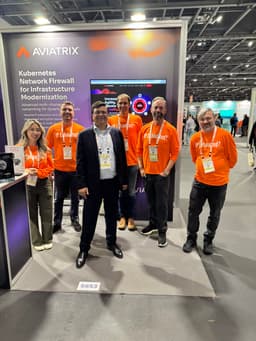There is no end to the number of cloud network security tools you could own – but tool fatigue, budget constraints, and management bandwidth means more tools and complexity. According to a recent study, organizations are struggling to deal with tool fatigue: survey respondents averaged 83 different security solutions from 29 vendors. And despite all these tools, the news is still full of massive data breaches.
Part of the problem is the sheer number of security tools: managing all of them strains security teams’ resources and attention and can create inoperability issues or false alarms, adding to the problem of signal noise. But as a recent Intellyx whitepaper shows, an even deeper issue is the approach taken by traditional tools:
Legacy models weren’t made for the cloud – Many traditional security tools are built for perimeter-based environments and don’t apply to distributed cloud networks with a new perimeter around every VPC/VNet, VM, container, and Kubernetes deployments.
Cloud-based solutions leave critical gaps – Other security tools were designed for the cloud, but they leave critical visibility and enforcement gaps that threat actors know how to exploit. Many of the cloud native tools available are also targeted towards a single cloud service provider or require bifurcation in how tools are deployed across CSPs.
What You’ll Learn:
The benefits and challenges of traditional CNAPP, CSPM, EDR, SASE, SSE, and NGFWs solutions
Why cloud native security fabric (CNSF) is needed
How Aviatrix CNSF provides runtime security that plugs the gaps other tools miss.
The Gaps Left by Existing Security Tools
Existing security tools help guard access points, identify misconfigurations, and flag anomalies in your network, but they leave security gaps:
CNAPPs and CSPMs: Warnings without Runtime Security
Cloud Native Application Protection Platforms (CNAPPs) and Cloud Security Posture Management (CSPM) tools defend cloud applications by finding and remediating misconfigurations and potential vulnerabilities in those environments.
CNAPP and CSPM tools are valuable for finding what could be or has been exploited, but they can’t provide runtime security to stop an active threat. In other words, they can help with proactive prevention and detection but not real-time crisis management.
SASE and SSEs: Access Protection without Full Visibility
Secure Access Service Edge (SASE) and Security Service Edge (SSE) tools create a global platform for network and security services to protect user access to resources.
SASE and SSE are great tools to help limit access to privileged resources in the cloud, and they typically do a good job of isolating users to the services they are allowed to access. However, most data attacks come from within your network, and a potential nefarious user with the right credentials isn't stopped by a SASE or SSE solution.
EDRs: Endpoint Protection that can be Dismantled
Endpoint detection and response (EDR) tools collect data and analyze threats for network endpoints to detect threats.
EDR tools are popular, but are increasingly vulnerable to being bypassed or dismantled by ransomware crews who use kernel-level EDR killers. EDRs that can be easily neutralized ultimately waste security teams’ time and resources. They also provide a false sense of security for security teams who rely on them to stop lateral movement and data exfiltration.
NGFWs: Robust Protection that Doesn’t Guard the Back Door
Next Generation Firewalls (NGFWs) are an industry standard for threat detection and traffic filtering through intrusion prevention and deep packet inspection.
However, NGFWs do not usually filter egress or outgoing traffic, meaning that threat actors who are already in the system can more easily exfiltrate data. They also depend on perimeter-based legacy thinking in a cloud world that has no single physical perimeter anymore – every workload, serverless, and Kubernetes cluster has a new micro-perimeter. There is also the unfortunate reality that centralized security functions increase data transfer costs, typically require load-balancers to steer and scale security needs, and inject a considerable amount of latency to application workloads.
"Each of these security tool categories (as well as numerous other three- and four-letter abbreviations) all offer narrow capabilities that leave gaps in organizations’ security response." Jason Bloomberg, "Is Zero Trust Out of Reach?"
Aviatrix Cloud Native Security Fabric: The Missing Control Layer
Aviatrix Cloud Native Security Fabric (CNSF) provides a holistic, unified security solution for complex and distributed networks. To explain its name:
Cloud Native – CNSF provides inline protection for workload-to-workload communication across clouds and on-premises locations. It was built for the cloud and doesn’t carry the assumptions of legacy solutions.
Security – CNSF’s feature set provides proactive and reactive security to keep threat actors out and shut down data breaches. It works at runtime, not post-attack.
Fabric – CNSF provides pervasive security that integrates with your existing security stack. Think of a security blanket that gives a layer of protection across clouds and workloads, ensuring the health and safety of your business.
Here’s how Aviatrix CNSF complements existing tools:
Runtime security – Unlike CNAPPs and CSPMs, Aviatrix works at runtime, not after the event. Using network-wide visibility and anomaly detection, it spots suspicious activity and enforces security policies to shut down an attack in flight.
Network segmentation – Aviatrix prevents lateral movement by segmenting your network and workloads, enforcing consistent security policies within and across VPCs/VNets and Clouds. Unlike SASE and SSEs, it stops attackers from moving through your system to collect and exfiltrate data.
Secure local VPC/Vnet breakout – Even if an attacker disables an EDR or other security solution, they’ll need to smuggle stolen data out of the network at some point. Aviatrix CNSF stops exfiltration in action by using advanced egress security as well as network-wide visibility to detect and stop exfiltration events before they start, without requiring backhauling traffic to a centralized security inspection VPC/VNet.
Identity-aware policies to prevent unauthorized lateral movement – Aviatrix CNSF bases its security policies on workload identity using metadata like tags instead of relying on IPs/CIDRs blocks, making sure misconfigured IP based polices or overlapping IP spaces don’t create holes in the security perimeter.
High Performance Encryption in transit – Aviatrix CNSF protects data-in-motion through high-speed IPSEC encryption that breaks past the 1.25gbs limit imposed by traditional IPsec-based solutions. It also doesn’t expose workloads to MiM (man in the middle) attacks like MACsec – a combination to make both security teams and network engineers happy.
Better visibility and diagnostic tools – The move to the cloud came at the cost of traditional tools being lost in the cloud. Aviatrix Policy Enforcement Points bring back tools like Ping, Traceroute, tcpdump, and netflow, while also bringing new tools like FlightPath.
Multicloud secure network infrastructure orchestration – Configuring and orchestrating security and network elements within a single cloud can be a very high-friction prospect. Using multiple clouds increases this friction, and getting these multicloud workloads to communicate securely often requires multiple teams to coordinate. With Aviatrix, you can do it all from a single pane of glass in a few clicks. You can also use Terraform to automate these deployments, resolving these connectivity issues in minutes vs. hours, days, and sometimes even weeks.
Tool sprawl is very real, as is the fatigue that comes with it. The tools you’re using today are most likely leaving you exposed in ways you won’t see until it's too late. Explore how Aviatrix CNSF can help you manage your infrastructure and security posture to minimize the SNR, and lower the friction on providing new secure services – giving you back time and peace of mind that your business is protected in the perimeterless world of the cloud.
Read the full Intellyx whitepaper here: “Is Zero Trust out of Reach?”
Discover zero trust blind spots that put your cloud at risk.


















